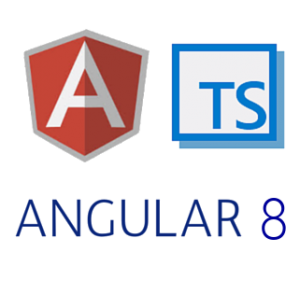Saturday-Sunday, 5 weeks (36 hours).


Target audience: Web application developers with practical experience using JavaScript.
Course duration and schedule: Duration of the course is 36 astr. hours total. Training will be conducted in 5 weekends (Saturday and Sunday, 9 days), 4 astr. hours each day.
Course Description:
The course provides in-depth study of state-of-the-art ECMAScript 6, 7, 8 & 9, TypeScript and MV* Angular 8 framework for rapid development of modern, component-based, mobile-first, responsive single-page applications that are easy to extend and maintain in long run. Angular builds on success of AngularJS web application development framework, but is significantly more efficient, streamlined, elegant and easy to learn.
The covered topics include:
- Introduction to TypeScript – functions, interfaces, classes and constructors. Common types: Boolean, Number, String, Array, Enum, Any, Void. Duck typing. Declaring contracts using Interfaces – properties and optional properties, function types, class types, array types, hybrid types, extension of interfaces. Classes – constructors, public/private properties, get and set accessors, static and instance sides. Functions and function types – optional default and rest parameters, function lambdas and use of this, overloads. Using Enums. Modules in TypeScript – namespaces and modules (former internal and external modules), using import, export and require. Interoperability with external JS libraries – ambient type declarations and ambient modules. Module resolution. Generic type parameters – writing generic functions and classes, generic constructors, bounded generics. Type inference and type compatibility. Declaration merging. Decorators. Configuring, building and deploying TypeScript project – typings for npm packages, compiler options. Integration with build tools – npm, webpack. (4 h.)
- Introduction to Single Page Applications (SPA) development using Angular and TypeScript – using Model-View-Controller (MVC), Model-View-Presenter (MVC), Model-View-ViewModel (MVVM) – MV* patterns for development of more complex, extensible and easy to maintain web applications. Using Visual Studio Code. Using Angular Command Line Interface (Angular CLI) to setup Angular project and add application components. Creating first Angular Todo application. Web components. Data binding. Angular application architecture – overview, main parts: Module, Component, Template, Metadata, Data Binding, Service, Directive, Dependency Injection. Component controllers, views & templates – syntax for defining templates for model data visualization, property bindings, event bindings, component styling. Using external template and style files. Ahead-of-Time Compilation (AOT). (3 h.)
- Displaying data using template interpolation and built-in directives: NgModel, NgFor, NgIf, NgSwitch, NgStyle, NgClass. Handling user input – binding event handlers, getting data from the $event object, using local template variables, event filtering, handling multiple events. Template expression writing guidelines. Binding targets – properties, events, attributes, classes and styles. Input and output properties – using @Input and @Output decorators. Emitting custom events with EventEmitter. Built-in directives and templates (*) in depth. Local template variables.Template expression operators – pipe ( | ) and safe navigation( ?. ) operators. Data bindings modification using built-in pipes – date, lowercase, uppercase, number, percent, currency, slice, async, json pipes. Angular by example – building Products Manager sample application. (4 h.)
- Angular tempale-driven and reactive forms – two-way data binding: [(ngModel)], change tracking, validation, and error handling: providing custom styles for different control states, resetting and submitting forms, edit/display forms. Using NgForm, NgControlName, NgFormControl, NgControlGroup, and NgFormModel directives to bind a domain model to the form. Reactive Forms using FormGroupDirective, FormControlDirective, FormControlName, FormGroupName, FormArrayName, and FormBuilder. Organizing FormControls using FormGroups and FormArrays. Using form validators – RequiredValidator, MaxLengthValidator, MinLengthValidator, PatternValidator directives and Validators class. Building custom validator directives by implementing Validator interface. Building asynchronous form validators. Demos and exercises. (4 h.)
- Angular services. Building custom services. Understanding Dependency Injection (DI) – DI using constructors, Angular DI framework, configuring the injector, registering providers in components, declarative and programmatic dependency injection, injecting service dependencies in a service using @Injectable decorator, registering custom providers using provide function, dependency injection tokens. Using hierarchical injectors. Demos and exercises. (2 h.)
- Angular HTTPClient and RxJS. Asynchronous data requests (AJAX) using XMLHttpRequest (XHR). Same origin policy and CORS. Using new Angular HTTPClient , interceptors, logging, caching responses, handling ProgressEvents. Building Observable services with Angular HTTPClient. Cross-origin requests – Wikipedia Search form demo. Reactive Extensions for JS (RxJS). Smoother UX using RxJS Observables, Subscribers, Subjects. Conversion to Promises. Composing functional operators for data stream transformation. RxMarble diagrams. (4 h.)
- Routing and navigation in Angular single page applications – setting the base href and importing ‘@angular/router’ module. Configuring a router using RouterModule.forRoot() and RouterModule.forChild() with Routes – paths and components. Building Routing Components – injecting Router service, providing router outlets using RouterOutlet directive, link parameters array that propels router navigation, navigating by user clicks – data-bound RouterLink directive, programmatic navigation using Router service, toggling active link CSS classes, embedding important information in the URL with route parameters, adding child routes under a feature section, using wild-cards, redirecting from one route to another, matching strategies (prefix vs. full), using empty-path route configurations, setting default routes, using multiple named outlets, componentless routes, lazy-loading feature modules. Accessing information about activated route using ActivatedRoute service – Observable params, data and resolves vs. non-observable (snapshot) alternative. Confirming or canceling navigation with guards – CanActivate to prevent navigation to a route, CanDeactivate to prevent navigation away from current route. Passing optional information in query parameters, jumping to anchors using fragments. Choosing between “HTML5” (history.pushState) and “hash” (“#”) URL navigation styles. (5 h.)
- Advanced Angular topics – custom pipes, custom directives, using Renderer2 class. Component lifecycle and use of custom lifecycle hooks: ngOnInit, ngOnChanges, ngDoCheck, ngOnDestroy, ngAfterContentInit, ngAfterContentChecked, ngAfterViewInit, ngAfterViewChecked. Usage examples. Accessing component’s ViewChildren and ContentChildren using @ViewChild, @ViewChilderen, @ContentChild, @ContentChildren decorators. Component providers and viewProviders. Shadow DOM and Angular view encapsulation modes – ViewEncapsulation.None / Emulated / Native. Zones & change detection. Angular component performance optimization strategies. (4 h.)
- Reactive Extentions for Angular (NGRX) – Flux and Redux design patterns, main components and their interactions – Actions, Action Creators, Reducers, Store, Selectors. Predictable reactive state management with NGRX/store. Reselect-style computing of derived data with RxJS. Implementing asynchronous state transitions using NGRX/effects and @Effect decorator. NGRX Router integration. Using custom RouterStateSerializer. Using Redux devtools Chrome extension. (4 h.)
- Angular animations. I18n. Q&A – quick-start example, states and transitions, entering and leaving from different states, animation timing, keyframe animations. Angular i18n – i18n pipes, template translations, source file generation with ng xi18n, merging app and translations with JIT and AOT. (2 h.)
During the workshop participants will get practical experience using Angular TypeScript framework and Angular CLI for building single page applications. Training is conducted in small groups – up to 10 participants. There will be opportunity for discussion of additional questions the participants are interested in.
 Viewing detailed program of the course in PDF format
Viewing detailed program of the course in PDF format
For more information, please send us an e-mail at: office@iproduct.org
Schedule & Enrollment


